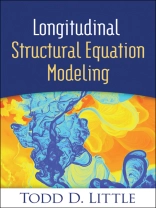Featuring actual datasets as illustrative examples, this book reveals numerous ways to apply structural equation modeling (SEM) to any repeated-measures study. Initial chapters lay the groundwork for modeling a longitudinal change process, from measurement, design, and specification issues to model evaluation and interpretation. Covering both big-picture ideas and technical ’how-to-do-it’ details, the author deftly walks through when and how to use longitudinal confirmatory factor analysis, longitudinal panel models (including the multiple-group case), multilevel models, growth curve models, and complex factor models, as well as models for mediation and moderation. User-friendly features include equation boxes that clearly explain the elements in every equation, end-of-chapter glossaries, and annotated suggestions for further reading. The companion website (www.guilford.com/little-materials) provides datasets for all of the examples–which include studies of bullying, adolescent students’ emotions, and healthy aging–with syntax and output from LISREL, Mplus, and R (lavaan).
Innehållsförteckning
PROLOGUE* A personal introduction and what to expect How statistics came into my life My approach to the book Key features of the book Overview of the book* Datasets and measures used My dataset with the Inventory Felt Energy and Emotion in Life (I FEEL) measure The I FEELGallagher and Johnson’s MIDUS example Neuroticism Negative affect Dorothy Espelage’s bullying and victimization examples Peer victimization Substance use Family conflict Family closeness Bullying Homophobic teasing* Overdue gratitude* Prophylactic apologies1. OVERVIEW AND SEM FOUNDATIONS* An overview of the conceptual foundations of SEMConcepts, constructs, and indicators From concepts to constructs to indicators to good models* Sources of variance in measurement Classical test theorem Expanding classical test theorem* Characteristics of indicators and constructs Types of indicators and constructs Categorical versus metrical indicators and constructs Types of correlation coefficients that can be modeled* A simple taxonomy of indicators and their roles* Rescaling variables* Parceling* What changes and how?* Some advice for SEM programming* Philosophical issues and how I approach research* Summary* Key terms and concepts introduced in this chapter* Recommended readings2. DESIGN ISSUES IN LONGITUDINAL STUDIES* Timing of measurements and conceptualizing time Cross-sectional design Single-cohort longitudinal design Cross-sequential design Cohort-sequential design Time-sequential design Other validity concerns Temporal design Lags within the interval of measurement Episodic and Experiential Time* Missing data imputation and planned missing designs Missing data mechanisms Recommendations and caveats Planned missing data designs in longitudinal research* Modeling developmental processes in context* Summary* Key terms and concepts introduced in this chapter* Recommended readings3. THE MEASUREMENT MODEL* Drawing and labeling conventions* Defining the parameters of a construct* Scale setting* Identification* Adding means to the model: Scale setting and identification with means* Adding a longitudinal component to the CFA model* Adding phantom constructs to the CFA model* Summary* Key terms and concepts introduced in this chapter* Recommended Readings 4. MODEL FIT, SAMPLE SIZE, AND POWER* Model fit and types of fit indices Statistical rationale Modeling rationale The longitudinal null model Summary and cautions* Sample Size* Power* Summary* Key terms and concepts introduced in this chapter* Recommended readings5. THE LONGITUDINAL CFA MODEL* Factorial invariance* A small (nearly perfect) data example Configural factorial invariance Weak factorial invariance Strong factorial invariance Evaluating invariance constraints Model modification Partial invariance* A larger example followed by tests of the latent construct relations Testing the latent construct parameters* An application of a longitudinal SEM to a repeated-measures experiment* Summary* Key terms and concepts introduced in this chapter* Recommended readings6. SPECIFYING AND INTERPRETING A LONGITUDINAL PANEL MODEL* Basics of a panel model* The basic simplex change process* Building a panel model Covariate/control variables Building the panel model of positive and negative affect* Illustrative examples of panel models A simplex model of cognitive development Two simplex models of non-longitudinal data A panel model of bullying and homophobic teasing* Summary* Key terms and concepts introduced in this chapter* Recommended readings7. MULTIPLE-GROUP MODELS* Multiple-group longitudinal SEMStep 1: Estimate missing data and evaluate the descriptive statistics Step 2: Perform any supplemental analysis to rule out potential confounds Step 3: Fit an appropriate multiple-group longitudinal null model Step 4: Fit the configurally invariant model across time and groups Step 5: Test for weak factorial (loadings) invariance Step 6: Test for strong factorial invariance Step 7: Test for mean-level differences in the latent constructs Step 8: Test for the homogeneity of the variance–covariance matrix among the latent constructs Step 9: Test the longitudinal SEM model in each group* A dynamic p-technique multiple-group longitudinal model* Summary* Key terms and concepts introduced in this chapter* Recommended readings8. MULTILEVEL GROWTH CURVES AND SEM* Longitudinal growth curve model* Multivariate growth curve models* Multilevel longitudinal model* Summary* Key terms and concepts introduced in this chapter* Recommended readings9. MEDIATION AND MODERATION* Making the distinction between mediators and moderators Cross-sectional mediation Half-longitudinal mediation Full longitudinal mediation* Moderation* Summary* Key terms and concepts introduced in this chapter* Recommended readings10. JAMBALAYA: COMPLEX CONSTRUCT REPRESENTATIONS AND DECOMPOSITIONS* Multitrait-multimethod models* Pseudo-MTMM models* Bifactor and higher order factor models* Contrasting different variance decompositions* Digestif* Key terms and concepts introduced in this chapter* Recommended readings
Om författaren
Todd D. Little, Ph D, is Professor of Educational Psychology and Leadership at Texas Tech University and founding Director of the Texas Tech University Institute for Measurement, Methodology, Analysis, and Policy. Dr. Little is a Fellow of the American Association for the Advancement of Science; the American Psychological Association (APA) Divisions 5, 7, and 15; and the Association for Psychological Science. He is past president of APA Division 5 (Evaluation, Measurement, and Statistics). Dr. Little organizes and teaches in his renowned ’Stats Camp’ each June. Partly because of the impact and importance of Stats Camp, Dr. Little was awarded the Cohen Award from APA Division 5 for Distinguished Contributions to Teaching and Mentoring.












